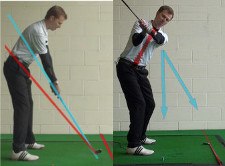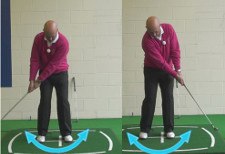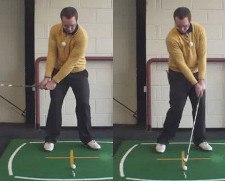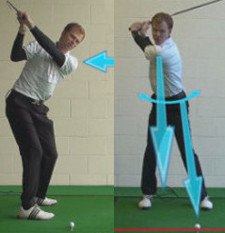- Tab 1
- Tab 2
- Tab 3
 The Best Golf Techniques Ever: There are countless techniques that have been used over the years in this great game, some more successful than others. We don't expect to cover all of the good ones in this article, of course. However, we are going to highlight some of the very best techniques which have been proven over the years to offer great results. With few exceptions, golfers around the world will be able to benefit from putting these methods to use.As is always the case with golf instruction, you should keep these techniques in perspective within the framework of your entire game. If a particular tip doesn't seem like it will work for you, there is no obligation to give it a try. Golf is a game that can be played a million different ways, so you always need to trust your gut instinct when making technical changes. We know that these techniques are some of the best in the game, but that does not mean they are guaranteed to bring you success. You know your own game best, so ultimately you make the decisions regarding which techniques are used and which are left to the side.Also, it needs to be noted that any technique – no matter how popular it maybe – should be learned in practice before it is attempted on the course. The shots you play during a round of golf should be limited to those which have been practiced at least a few times previously. If you are frequently trying new shots on the course without any preparation, you can expect to be disappointed by the results. Spend some time preparing and only take your new methods out to the course when you are confident that they will make you a better player.
The Best Golf Techniques Ever: There are countless techniques that have been used over the years in this great game, some more successful than others. We don't expect to cover all of the good ones in this article, of course. However, we are going to highlight some of the very best techniques which have been proven over the years to offer great results. With few exceptions, golfers around the world will be able to benefit from putting these methods to use.As is always the case with golf instruction, you should keep these techniques in perspective within the framework of your entire game. If a particular tip doesn't seem like it will work for you, there is no obligation to give it a try. Golf is a game that can be played a million different ways, so you always need to trust your gut instinct when making technical changes. We know that these techniques are some of the best in the game, but that does not mean they are guaranteed to bring you success. You know your own game best, so ultimately you make the decisions regarding which techniques are used and which are left to the side.Also, it needs to be noted that any technique – no matter how popular it maybe – should be learned in practice before it is attempted on the course. The shots you play during a round of golf should be limited to those which have been practiced at least a few times previously. If you are frequently trying new shots on the course without any preparation, you can expect to be disappointed by the results. Spend some time preparing and only take your new methods out to the course when you are confident that they will make you a better player.
All of the content below is written from the perspective of a right-handed golfer. If you happen to play left-handed, please take a moment to reverse the directions as necessary.
 The Pendulum Putting StrokeThis just might be the most-effective technique in the history of golf. While there is plenty of individuality in the golf swing, nearly all quality players approach putting in much the same way. The idea is simple – with the pendulum stroke, you take as many moving parts out of your technique as possible. The shoulders rock back and through to move the putter, while the hands and wrists just go along for the ride. This kind of putting provides reliable distance control, the ability to hit the target line over and over again, and stability under pressure. If you have long struggled with your putting performance, making the switch to a pendulum stroke is your best choice.If you would like to transition into a pendulum stroke, make sure you key on the following five elements as you practice.
The Pendulum Putting StrokeThis just might be the most-effective technique in the history of golf. While there is plenty of individuality in the golf swing, nearly all quality players approach putting in much the same way. The idea is simple – with the pendulum stroke, you take as many moving parts out of your technique as possible. The shoulders rock back and through to move the putter, while the hands and wrists just go along for the ride. This kind of putting provides reliable distance control, the ability to hit the target line over and over again, and stability under pressure. If you have long struggled with your putting performance, making the switch to a pendulum stroke is your best choice.If you would like to transition into a pendulum stroke, make sure you key on the following five elements as you practice.
- Light grip pressure. This is the first point we are going to highlight simply because it is so important to making a successful pendulum stroke. If you hold tightly onto the grip of the putter, it will be extremely difficult to let your stroke flow freely as it should. Instead, you want to have very light grip pressure at address, with the club hanging from your hands without any tension at all in your fingers. The putting stroke is not an aggressive or violent action, so you don't really have to worry about the putter slipping out of your control during the shot. Commit yourself to start each stroke with a light grip and then maintain that feel all the way through to the finish.
- Stable head position. Here we find another key feature of a reliable pendulum putting stroke. From the time you settle into your stance to start the stroke, on through to the finish of the stroke, your head should be perfectly still. There is no need for your head to move while putting, as you aren't swinging the putter hard enough to require that kind of action. Get into a comfortable position, lock your eyes on a specific spot on the ball, and make a smooth stroke. By keeping your head still, it will become easier to swing the club freely back and through. Also, it will be easier to make contact with the ball on the center of the putter face. The temptation will always be there to look up early, but you can teach yourself through practice to resist this urge. Looking up early isn't going to help the ball find the bottom of the cup, so stay still and focus only on a smooth swinging action.
- Upright posture. One of the biggest mistakes seen in the amateur game is bending down too close to the ball when putting. If you hunch over in your putting stance, it will be hard to rock your shoulders correctly – meaning you will have to use your hands and wrists in order to send the ball toward the cup. By standing taller, you can create the pendulum shape necessary to make this kind of stroke. You still want to have some flex in your knees at address, but your upper body should be relatively vertical with only a slight tilt out from your hips. Work on this point on the practice green until you find your way into a comfortable position.
- Silent right hand. This technique is called a pendulum stroke because you are supposed to rock the club smoothly back and through the ball. Just like a pendulum clock, everything works together as one piece. That can't happen if your hands get involved in the action. Specifically, it is the right hand that will frequently become a problem. If you let your right hand take over the control of the putter at any point, the pendulum effect will be lost and you will probably hit a poor putt. If you are used to actively using your hands while hitting putts, taking your right hand out of the picture is going to take some time. Stick with it, however, as the best putting of your life will likely be waiting on the other side.
- Great tempo. The piece that is going to hold this entire stroke together is tempo. When you use a consistent, reliable tempo, you will be able to roll the ball with amazing consistency. Fortunately, it will be easier to find a good tempo when you don't have to worry about your hands getting in the way. It is relatively simple to rock the putter back and through at an even pace while you are only using your shoulders to drive the stroke. You are welcome to use a fast tempo, a slow tempo, or anything in between – as long as it is consistent, and as long as it feels natural to you.
Judging by the size of the list above, you might think the pendulum stroke is a complicated procedure. In fact, just the opposite is true. This is a relatively simple action to complete, and once you get comfortable with it, you should be able to do it over and over again without any trouble. For now, spend plenty of time on the practice green working on your pendulum action, and look forward to improved results as the weeks and months go by.
 Hitting Soft Wedge ShotsThere are plenty of situations during a round of golf where swinging hard is the right course of action. When you are standing on the tee of a par five, for instance, you can feel free to let it loose with the driver. There are other spots on the course, however, when it would be wise to back off and emphasize control over sheer power.One of those times is when you are hitting a wedge shot from the fairway. When hitting a wedge approach, the last thing you need to do is swing hard. On the contrary, you should be making a soft, controlled swing that will send the ball accurately to the target. You don't need raw power to hit the ball only 100-yards or so – you just need to be able to control it precisely.When you swing hard on a wedge shot, you will run into a couple of problems. First, you will put too much backspin on the ball. Yes, you do want some spin in order to stop the shot, but it is easy to get that much spin with modern equipment. By swinging hard, you will overload the ball with spin and it will be difficult to control your distance properly.
Hitting Soft Wedge ShotsThere are plenty of situations during a round of golf where swinging hard is the right course of action. When you are standing on the tee of a par five, for instance, you can feel free to let it loose with the driver. There are other spots on the course, however, when it would be wise to back off and emphasize control over sheer power.One of those times is when you are hitting a wedge shot from the fairway. When hitting a wedge approach, the last thing you need to do is swing hard. On the contrary, you should be making a soft, controlled swing that will send the ball accurately to the target. You don't need raw power to hit the ball only 100-yards or so – you just need to be able to control it precisely.When you swing hard on a wedge shot, you will run into a couple of problems. First, you will put too much backspin on the ball. Yes, you do want some spin in order to stop the shot, but it is easy to get that much spin with modern equipment. By swinging hard, you will overload the ball with spin and it will be difficult to control your distance properly.
The other problem with a hard wedge swing is the possibility of hitting the shot off-line. You should be able to hit your target line pretty regularly with a wedge, but you will get off-track if you start to swing too hard. Stay in control from start to finish and prioritize accuracy above all else.
There are a couple of things you can do to make sure your wedge swing remains controlled and balanced. First, you will want to choke down on the grip of the club slightly at address. This is going to bring your ball flight down, which is a good thing, and it will also shorten your swing (reducing your swing speed in the process). Also, you are going to move the ball back in your stance a bit. This is another adjustment that will lead to a lower flight, and it will also prevent the ball from spinning back toward the front of the green after it lands.
Once you get comfortable with using soft swings on your wedge shots, you will wonder how you ever played any other way. This is easily one of the best golf techniques ever because it can help you set up plenty of easy birdie chances. The ability to hit wedge shots close to the hole is extremely valuable in golf, and swinging softer may be the only change you need to make in order for that to happen.

A great shoulder turn can be considered the foundation of any quality, modern golf swing. This will be the last golf technique that we highlight in this article, and we have picked it from the many options because it is so important to your success. If you are going to hit powerful, accurate golf shots on a regular basis, you must turn your shoulders – it really is that simple.
On the surface, it would seem like a good shoulder turn would be pretty simple. You just turn your back to the target and swing away, right? Well, actually, it doesn't need to be much more complicated than that. However, there are a few points you should keep in mind while you practice. During your next range session, work on building a great turn while thinking about these keys.
- Give yourself enough time. There is often a battle in the amateur golf swing between the shoulder turn and the urge to rush through the swing. A proper shoulder turn takes time, but many golfers simply aren't willing to give themselves enough time to make the turn fully. Slow yourself down, push away the urge to rush through your swing, and let the motion develop naturally. When you take your time, you may be surprised to learn how easy it is to rotate all the way back.
- Maintain the flex in your knees. The connection between your upper body and the lower body in the golf swing is important. These two halves of your body need to work together if you are going to achieve your goals. During the swing, make sure to keep your knees flexed, just as they were at address. If you come up out of your stance by straightening your knees – which is a common mistake – it will be nearly impossible to finish your turn. You should feel like you are 'sitting' into your stance throughout the entire backswing. Knee flex will provide you with a great base for your swing, and that base is going to help you master the shoulder turn you need for maximum power.
- Stay wide. This is the second time in this article we have mentioned the width of your swing. In this case, it is important to maintain the width of your swing going back because that width will help pull you into a full turn. Should you allow your swing to get narrow, it will be hard to finish off the turn properly. Instead, you will probably give up on the turn and transition prematurely into the downswing. Keep your swing wide going back and don't do anything to give away that width throughout the rest of the swing.
There are plenty of great golf techniques to pick from when you are trying to improve your golf game. It's easy to get pulled in various directions while working on your swing, but you should stick with the basics that have worked for millions of golfers over the years. The four golf techniques we have highlighted in this article are not the only ones that can help you lower your scores, but they are a great starting point. Use these tips to guide your practice sessions and improved performance should be waiting just around the corner. We hope the advice we have provided will benefit your game in the near future – good luck!




